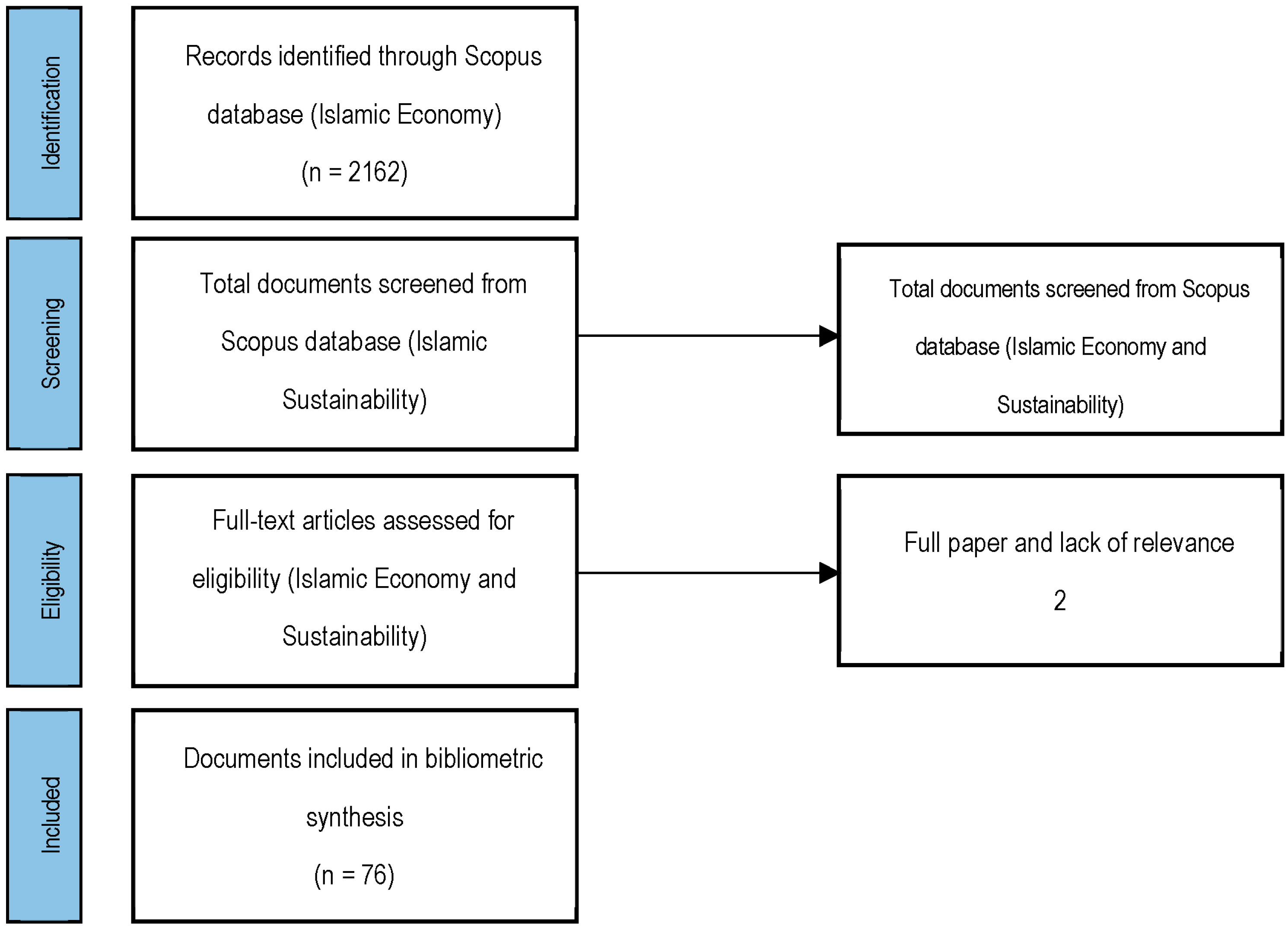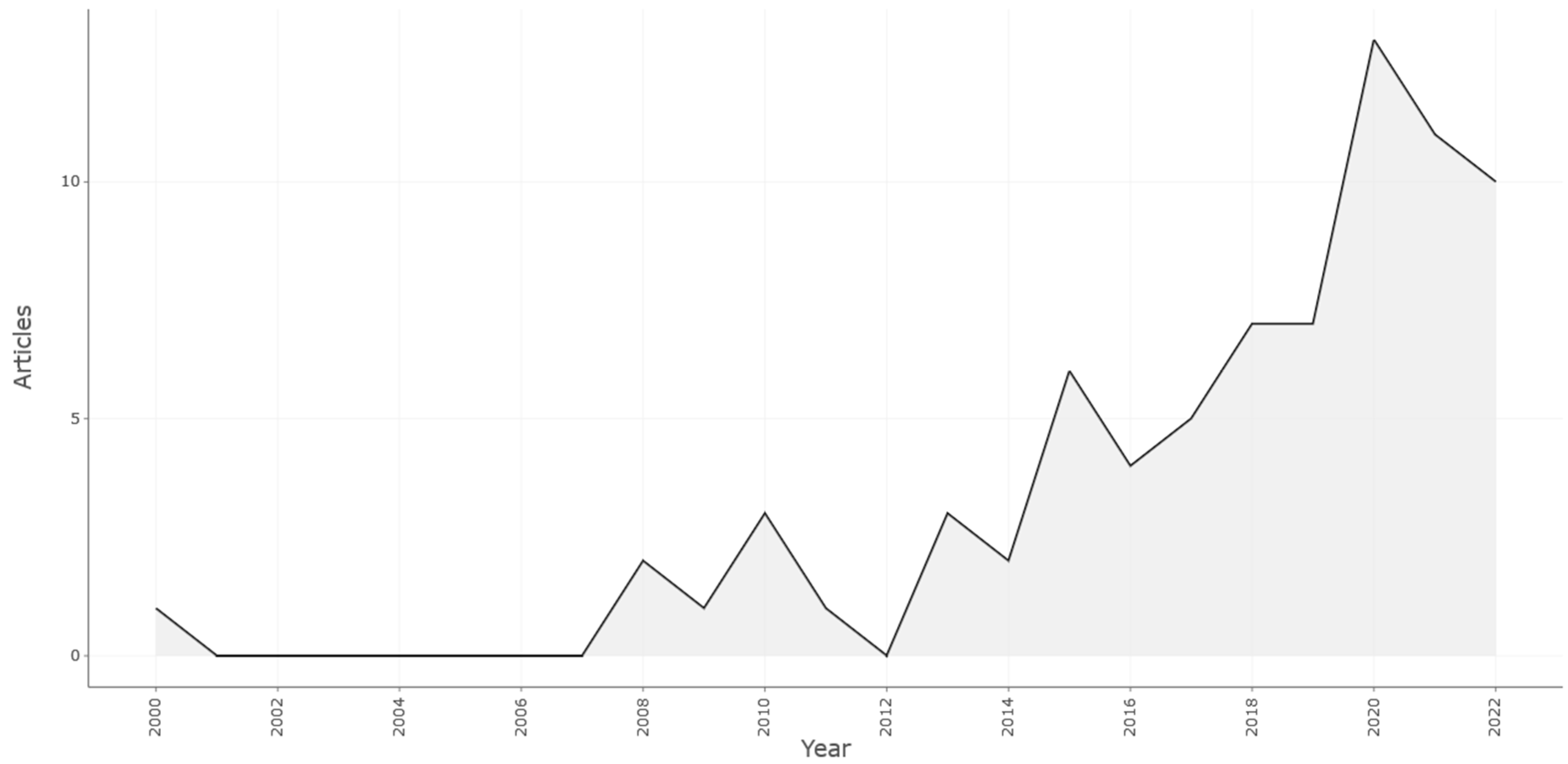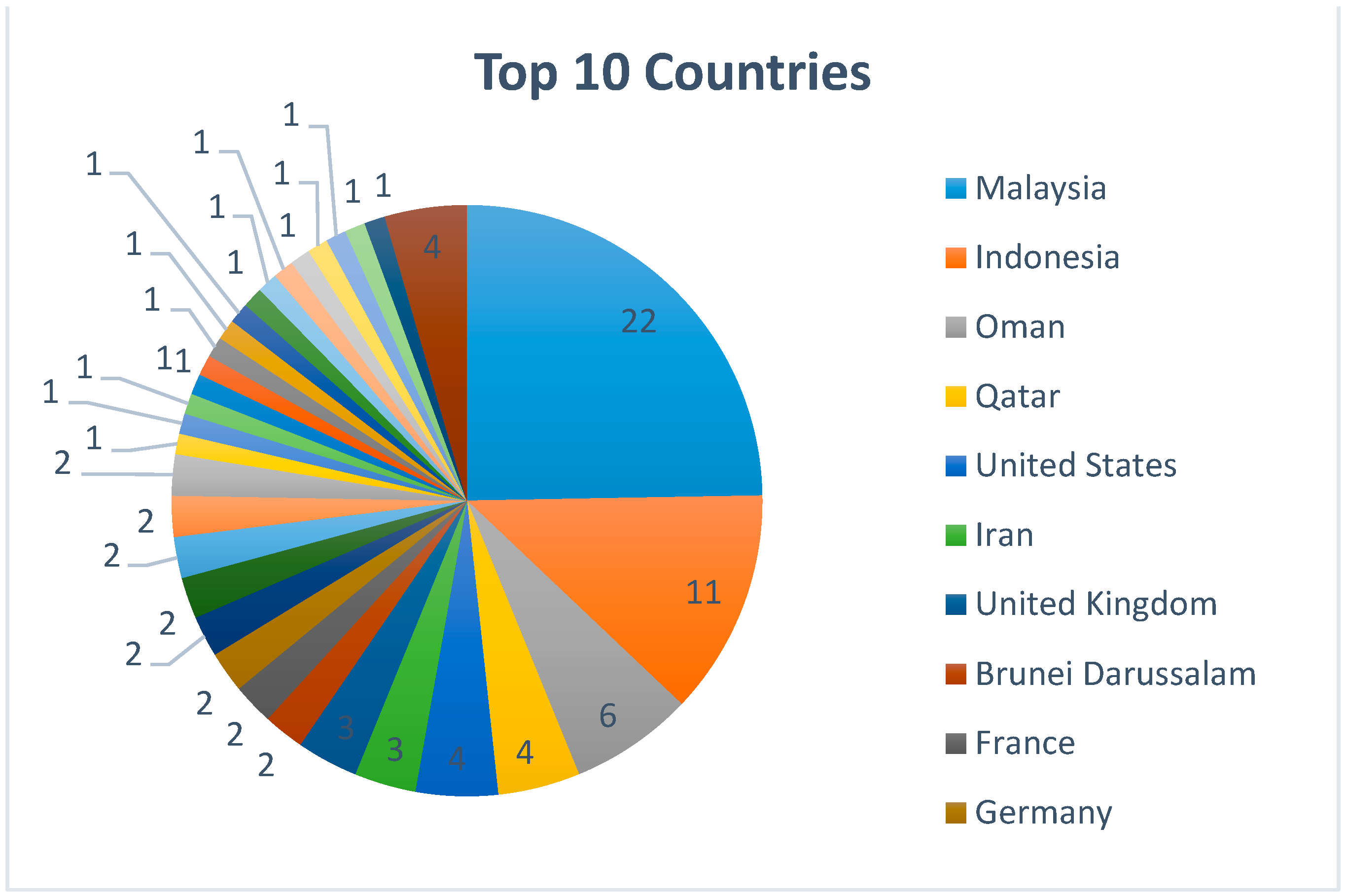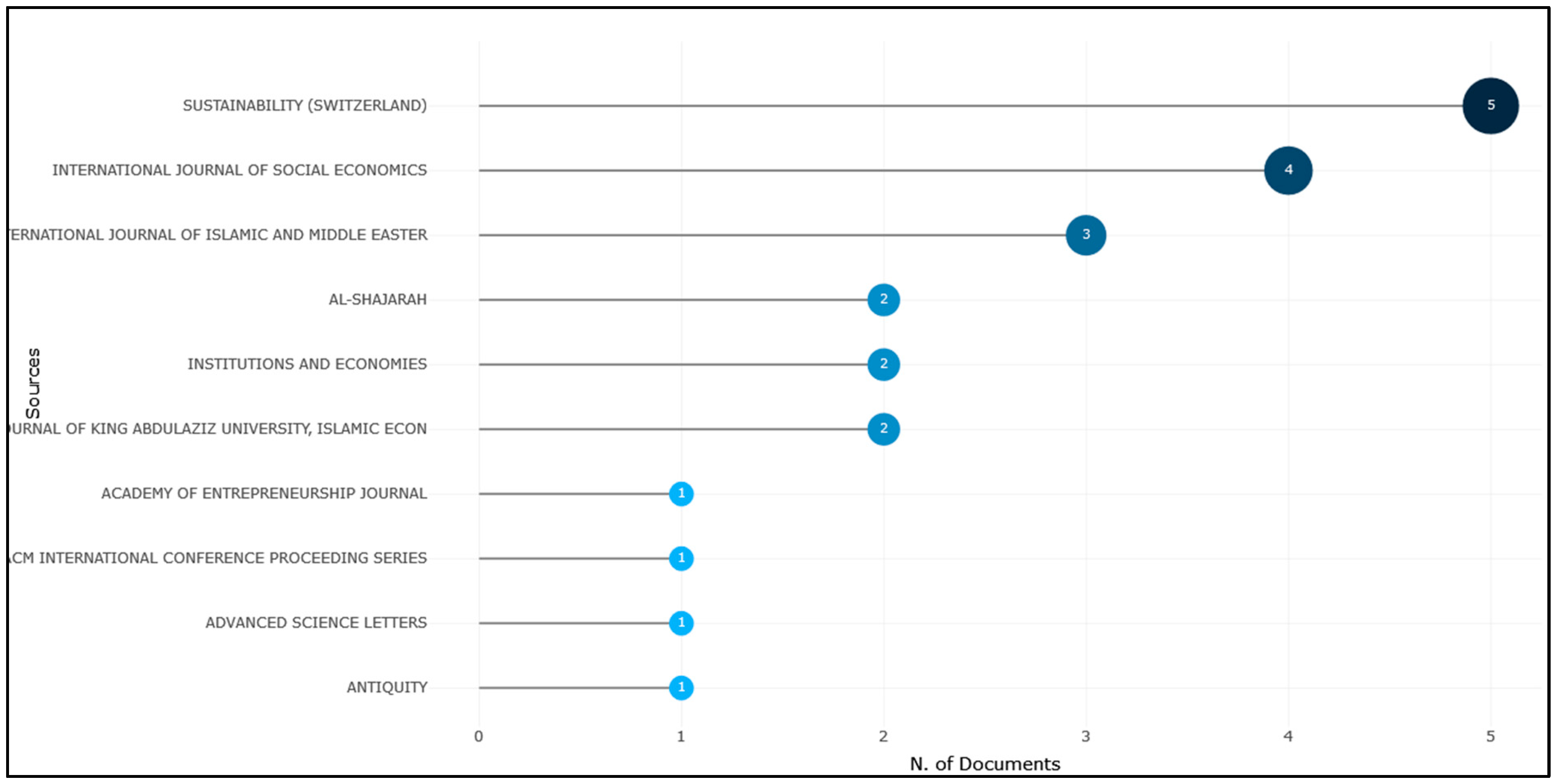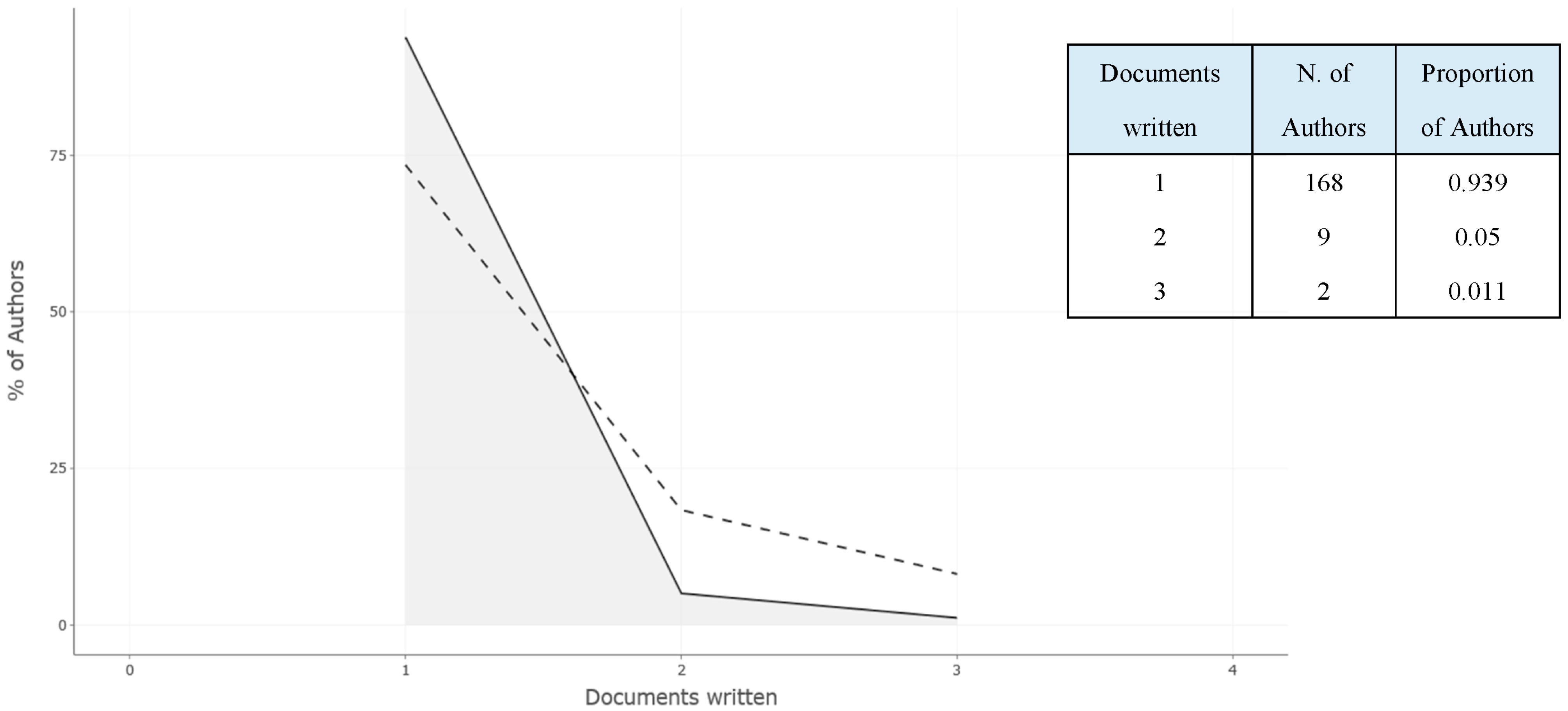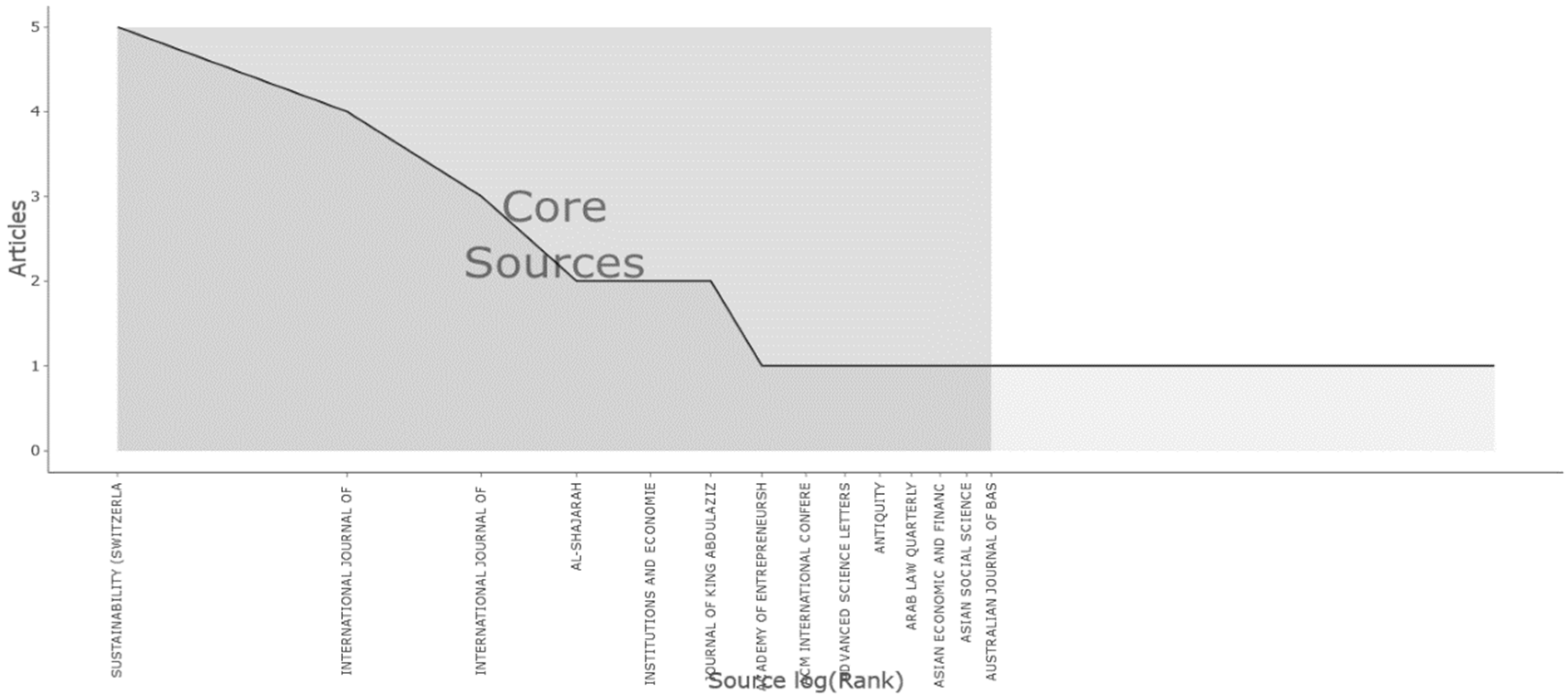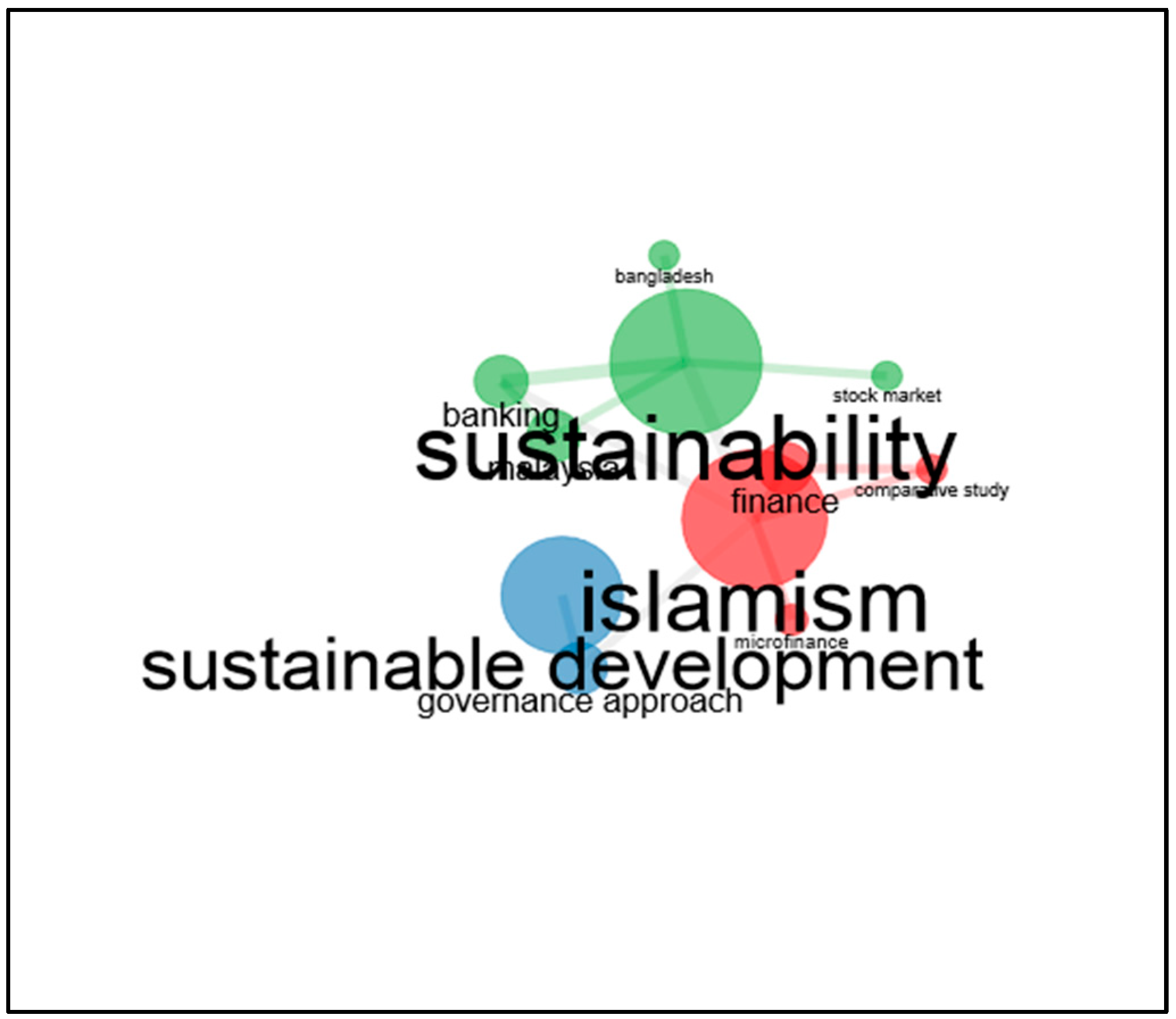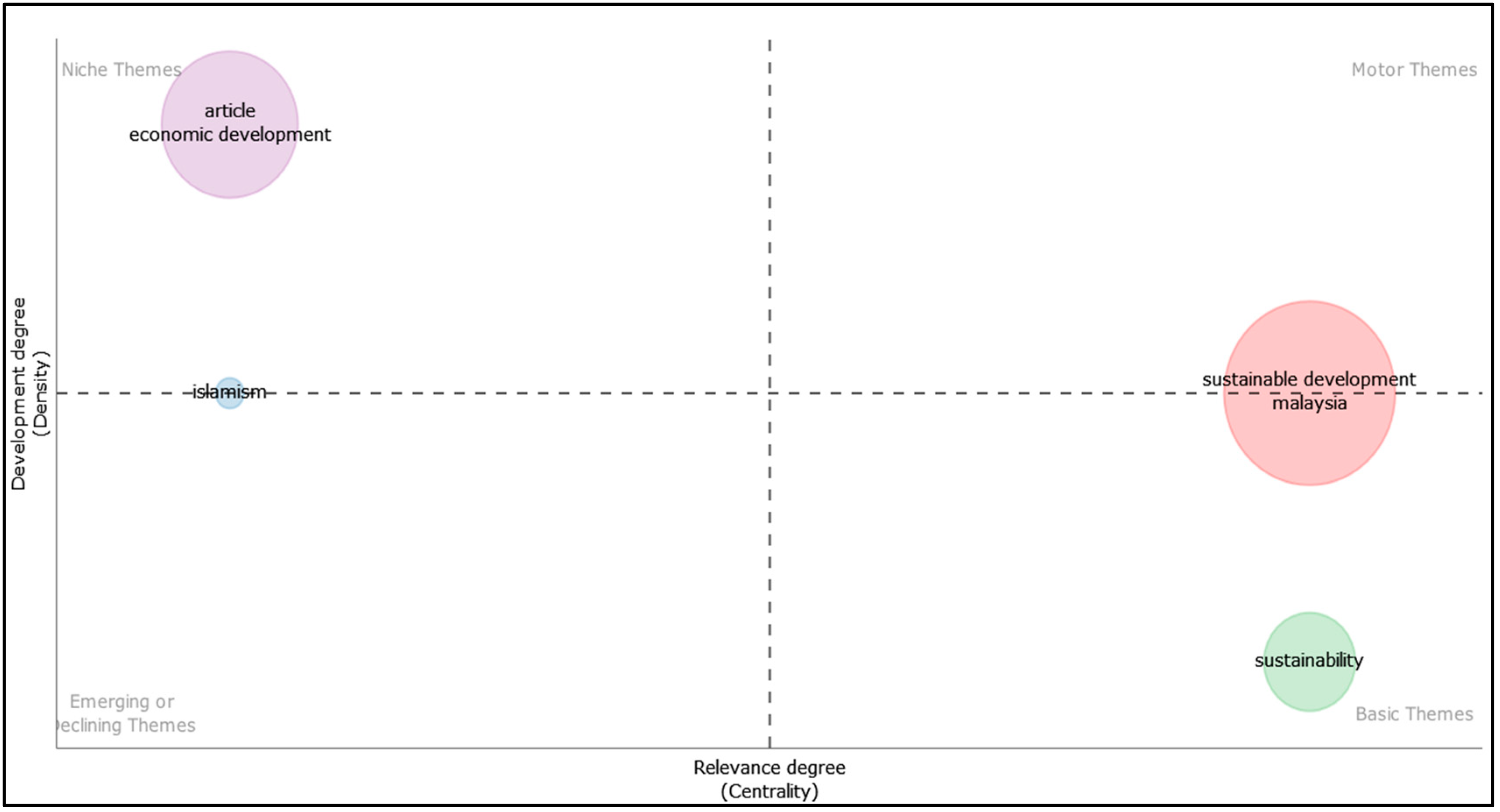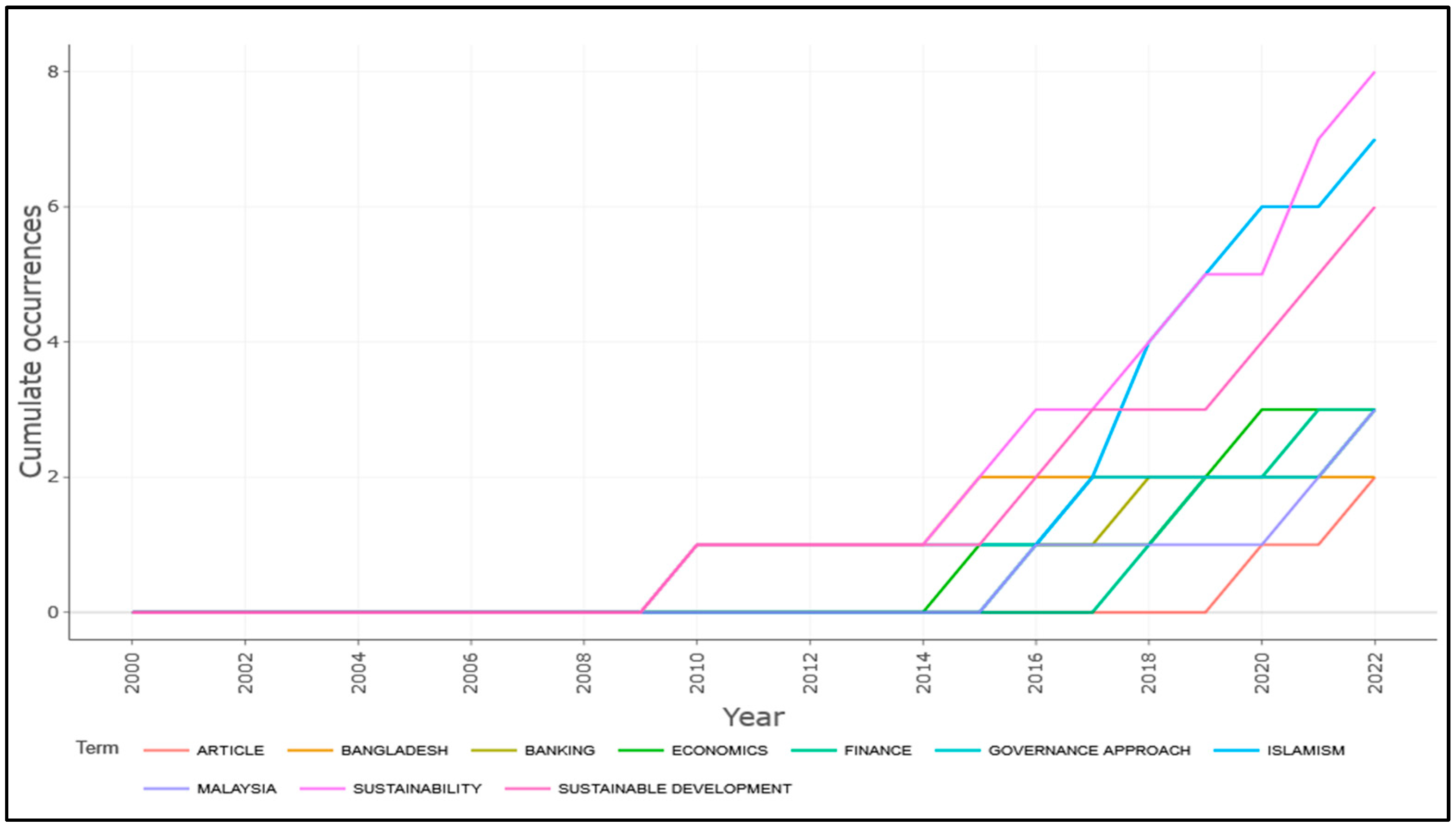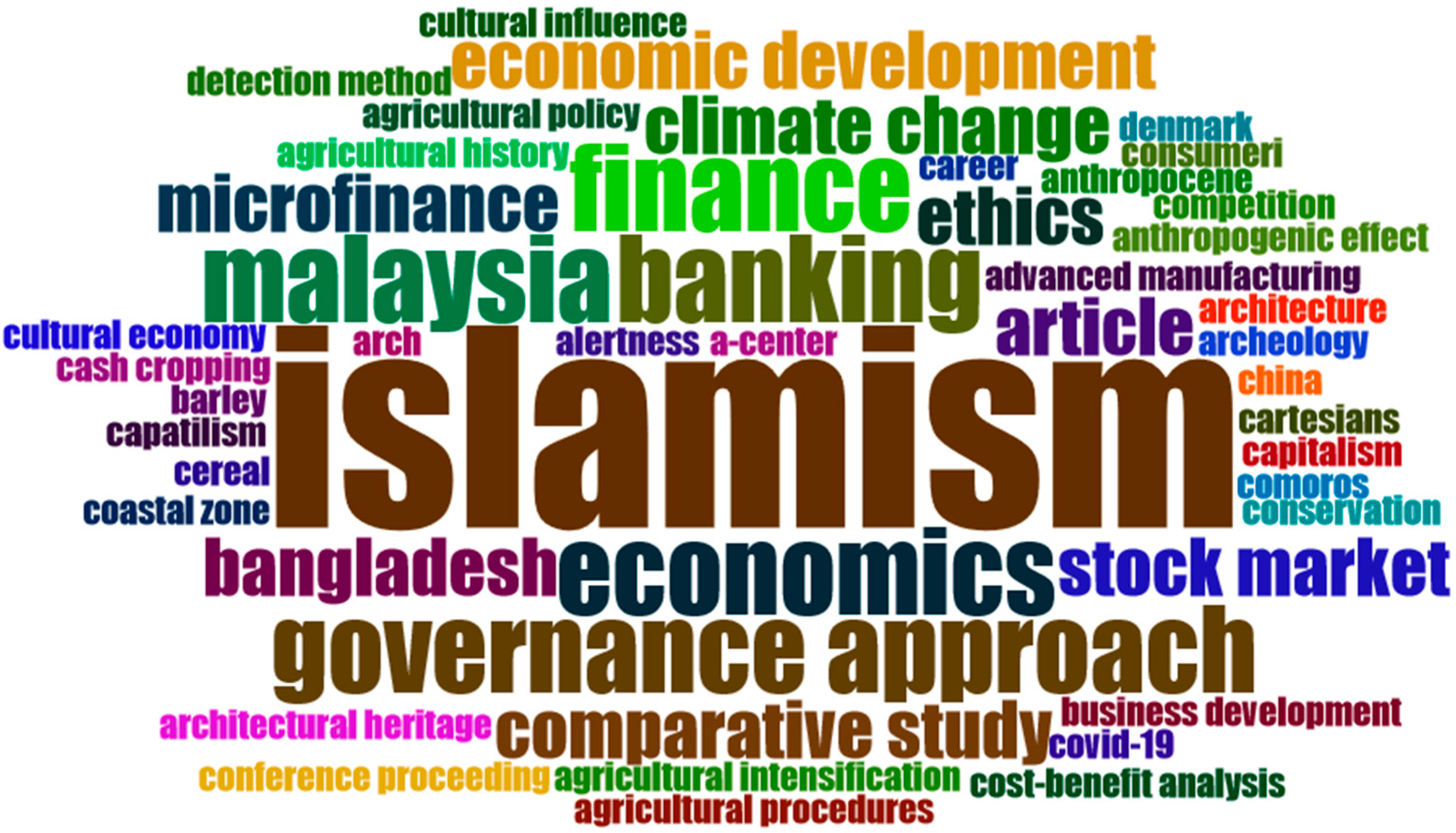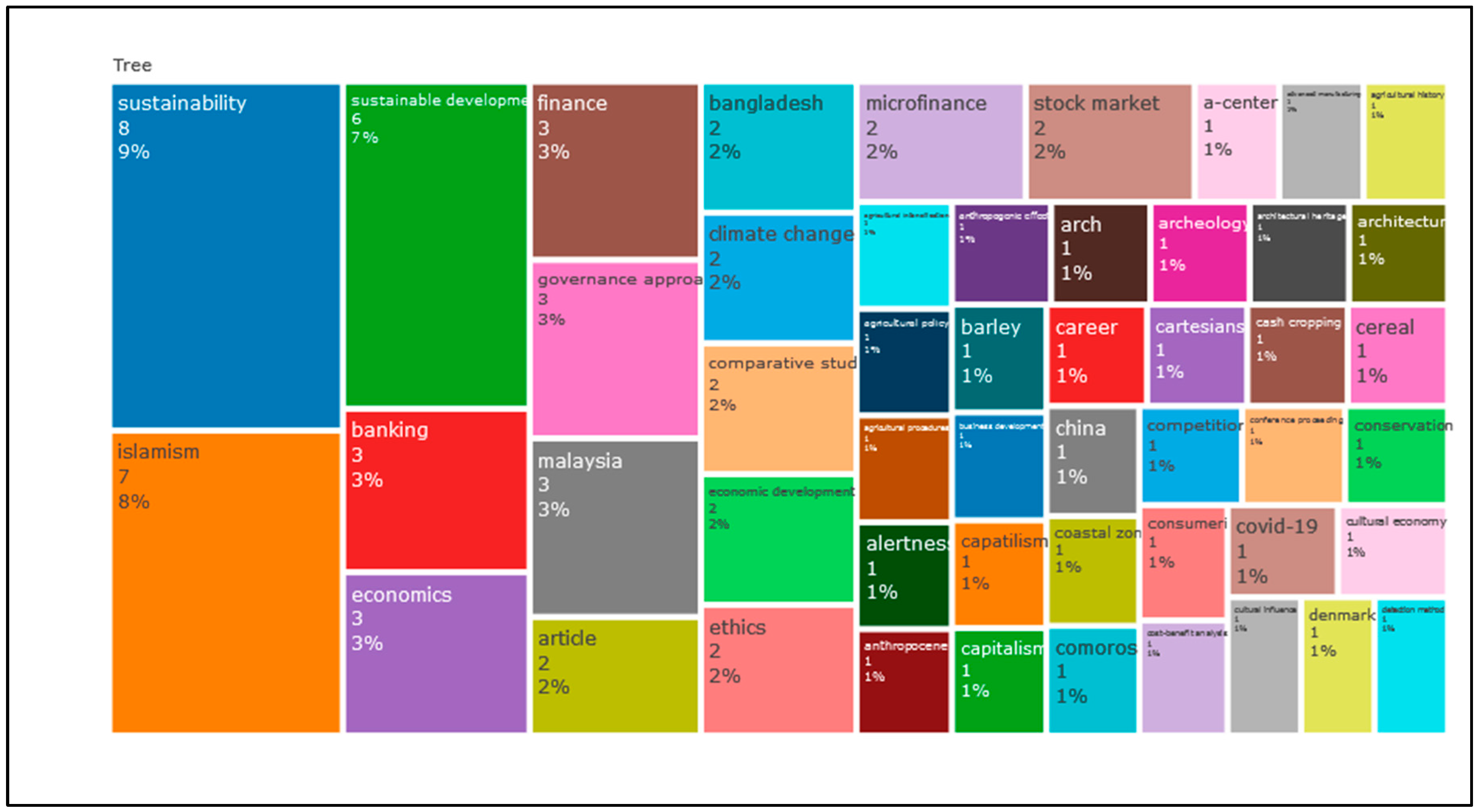4.1. Document Profiles
The articles that were found spanned the years 2000 to 2022. Only after 2000 did publications start to become more organised, and they also began to increase gradually and consistently in number. Based on the total of 76 documents (
Table 5) taken into account, there is 11.03% annual growth, and the average citation per document is 4897, while the total number of references involved is 3928. Furthermore, most work in this area is published as articles (73.68 percent), followed by reviews (9.21 percent).
RQ1: What is the current state and trend of publication in Islamic Economy and Sustainability?
The number of publications published connected to the concepts of Islamic economy and sustainability has increased over time, as shown in
Figure 2. The subject and scope of the study on Islamic economy and sustainability have received substantial attention from prior studies, according to the number of publications generated. Based on preliminary data from the Scopus database, the Islamic economics field began to gain more attention in the early 2000s, despite the relatively small number of publications on the subject then. The increase started in 2014 until now.
According to the data presented in
Figure 2, only 14 out of 76 publications were successfully published between 2000 and 2014. This low number of articles may be a result of this topic’s unpopularity in mainstream media discussion. The inability of industry players and academics to see the significance of Islamic economics in a broader context has stifled dialogue. However, from 2015 to 2020, the number of articles began to climb. Following that, the number of publications decreased from 2020 to 2022. The global Covid-19 pandemic may have exacerbated this condition. Nevertheless, the number of articles published from 2019 to June 2022 was the highest at 35. Specifically, the highest number of papers were published in 2020 (12), followed by 2021 (9) and 2018 (8).
Figure 2 and
Figure 3 show that the top ten countries and categories of papers relating to the Islamic economy and sustainability are highlighted. At the same time, Malaysia (with 22 articles), Indonesia (with 11 articles), and Oman (with six articles) are the top three countries that publish the most articles in this field. Even though most publications are in the form of articles (74.35%) and review papers (8.97%), many other types of documents are also published. Overall, Islamic economics and sustainability is a topic that is actively discussed in Malaysia, while conferences are popular places for exploring and exchanging ideas.
Despite the ongoing uncertainty related to the pandemic, projections for worldwide Muslim spending in 2022 indicate a 9.1% increase in the Islamic economy sectors based on the current status and trend in Islamic economy and sustainability [
34]. Concurrently, this assertion is supported by the fact that several key drivers continue to underpin the global Islamic economy. These drivers include the world’s large and growing Muslim population, the increasing desire to adhere to Islamic ethical values relating to the consumption, and the increasing number of national strategies dedicated to the development of halal products and services. Overall, the Islamic economy has risen to the top of the agenda in many nations and is regarded as a crucial component of economic recovery efforts.
RQ2: What are the most influential contributors to Islamic Economy and Sustainability?
In this second research question, the study focuses on the most influential authors, the author’s production over time, the most influential countries and institutions, and the most influential source title in the area of Islamic economy and sustainability.
Table 6 reveals that the sample database contained the most influential authors and articles. In general, there are five influential authors, namely, Choudhury Ma (2010; 2010; 2018), Ismail Ag (2011; 2017; 2021), Oseni Ua (2013; 2015), Javaid O (2022), and Tok E (2022). Ismail Ag. Has the highest total number of citations, with 24, followed by Choudhury Ma, with 14 citations. At the same time, two new authors (Javaid, 2022 and Tok, 2022) also contribute to publishing the Islamic economy and sustainability. According to
Table 6, there are two articles with the most citations. Among them are (1) “Taking Stock of the Islamic Microfinance Model Based on Waqf” and (2) “Financial sustainability & outreach of MFIS: a comparative analysis of goal in Malaysia and RDS of Islami bank Bangladesh”, with a total of 12 and 11 citations, respectively.
Table 7 reveals that the sample database contained the most influential journals. Business and economics journals have generally dominated Islamic economy and sustainability-related publications. With four papers, a three h-index, and 26 citations, the International Journal of Social Economics has the most publications. This circumstance is partly attributable to the fact that the journal has been publishing since 2010. Al-Shajarah and Institutions and Economics have two publications and eleven and twelve citations, respectively. This study also shows other journals outside the business and economics disciplines, including
Advanced Science Letters and Antiquity, with one (1) and seventeen (17) citations.
The most esteemed academic journals are peer-reviewed, which means that experts in their respective fields, other than the author and editor, assess each piece before publication. They should ensure that new information is presented in the context of what is previously known, that the researcher employed appropriate techniques, and that the paper contributes to the field. According to
Figure 4, the ten most relevant sources on Islamic economics and sustainability are shown. The
Sustainability journal is the most prominent publication in this discipline, followed by the
International Journal of Social and Economic Studies and the
International Journal of Islamic and Middle Eastern Studies. This journal is very significant since its publishing procedure involves peer review, ensuring its accuracy and contribution to its respective fields.
According to the aforementioned data, there is a relationship between author esteem and academic accomplishment that is beneficial, suggesting that emphasising the Islamic economy and sustainability-related concerns will have a positive impact on the economy and society. A thorough investigation of this subject is essential, given that investments in the Islamic economy sector in a few OIC and non-OIC economies grew by 118% from USD11.8 billion in 2019/20 to USD25.7 billion in 2020/21 [
34]. The biggest investment volume was seen in the UAE, Indonesia, and Malaysia, with the UAE accounting for 16% of all deals. Moreover, halal food and Islamic finance, in terms of sectors, accounted for 15.5% and 66.4% of the total transaction value, respectively [
26].
RQ3: What are the most influential articles and sources on Islamic Economy and Sustainability?
4.1.1. Highly Cited Documents/Papers
This prestigious ranking acknowledges the world’s best researchers whose Web of Science citation records are rated in the top (i.e., one percent) of their discipline. Being included on the most cited documents list indicates that you are a successful and influential scholar. Moreover, the visibility and potential reputation of the researchers’ affiliations with larger institutions increases substantially with the number of times their publications are mentioned [
35]. However, the total of citations an article receives is influenced by various external variables that do not seem to be directly connected to the “quality” of the article’s content [
36]. According to
Table 8, the ten most cited documents and papers on the field of Islamic economics and sustainability are shown. Belal Ar (2015), who has 68 (33.7%) total citations, is among the most notable, followed by Ali Bja (2021), who has 22 (10.9%) total citations. Other papers range from 11 to 17 total citations. The topics covered, meanwhile, are relatively wide and not particularly related to Islamic sustainability and economics.
4.1.2. Author Impact
Based on the h-Index, authors whose papers have been published can also be ordered based on the ensuing impact [
37]. The most commonly used index is the H-index (an author has an h-index of h if they have at least h works that have been referenced h times). The g-index comprises the g articles with the most citations [
38]. Meanwhile, the m-index is calculated by dividing the h-index by the number of years a scientist has been active.
Table 9 shows the authors with the highest h-index obtained by Bar-Oz G, Choudhury Ma, Fuks D, Ismail Ag, Oseni Ua, Tepper Y, and Weiss E with the achievement of a total 2 h-index that describe significant impact. Then followed by three authors (i.e., A Whaid N, Abd Majid Ms, Abdelsalam O) with an h-index value of 1, with a fairly good impact. Additionally, Choudhury Ma and Ismail Ag demonstrate the highest g-index value. Besides, the most active authors are Bar-Oz G, Fuks D, Tepper Y, and Weiss E with an m-index value of 0.286. Finally, the most significant contributor with the highest citation (i.e., TC) is Abdelsalam O with a total of 68 (28.6%) citations, followed by four authors (Bar-Oz O, Fuks D, Tepper Y, and Weiss E) with a total citation of 30 (12.6%). All this information was produced around the year 2011 to 2021.
4.1.3. Lotka’s Law
Lotka’s Law is the well-known “inverse square law of scientific creation”. It argues that the proportion of authors publishing a particular number of articles to those publishing a single article remains constant [
39]. In other words, it describes the authors’ frequency of publication in any field [
40]. Since then, several academics from different disciplines have utilised Lotka’s Law to analyse author productivity and publications [
39].
Figure 5 presents the distributions of the observed and the fitted Lotka’s. Between 1 and 3 papers have been published.
Figure 5 below clearly illustrates that the number of authors participating decreases as the number of articles published increases. Since Lotka’s law provides a framework for assessing an author’s productivity over time, it is clear that this area of the Islamic economy is quite dynamic and attracts a lot of interest from academics and practitioners. Knowing the authorship production pattern of Islamic economic literature will be valuable for both collective and individual interests.
4.1.4. Source Impact
Journal assessments are determined based on more than just the quantity produced or its relevancy [
27]. This study, however, is also conducted utilizing the impact of each journal that publishes a paper on the topic of Islamic economy and sustainability by calculating the journal’s h-index, g-index, m-index, and total citation. According to the statistics in
Table 10, the
International Journal of Social Economics ranks first with an h-index of 3, g-index of 4, m-index of 0.21, and total citations of 26. As such, the
International Journal of Social Economics has the greatest impact on the study of the Islamic economy and sustainability. In comparison, the second, third, and fourth positions are
Al-Shajarah,
Institutions and Economies, and
Sustainability (Switzerland) with 2 h-index. Their total number of citations varied from 11 to 23. Concerning journals with h-index 1, there are 6 journals with a total number of citations ranging from 1 to 17, which shows the journal has a minimal impact.
4.1.5. Bradford’s Law
Bradford’s rule predicts that the number of journals in the second and third zones will be n and n2 times bigger than the first zone; hence, it should be able to forecast the total number of journals carrying articles on a subject if the core and middle zone numbers are known [
40,
41]. Once the total number of articles is known, it should be able to estimate how much pertinent material is missing from an incomplete search. Given the time-consuming and substantial work necessary to discover sources on a topic for a systematic review, it would be advantageous for such research if Bradford’s law properly predicted the amount (and, if feasible, quality) of the literature [
39].
The image above shows a journal categorization based on Bradford law, which divides journals by production level into core, intermediate, and wide groups. The key journal groupings are coloured and annotated. This category includes journals having the most Islamic economy research output during a specific time.
Figure 6 shows the ten most relevant sources on the subject of Islamic economy and sustainability. The
Sustainability (five papers) journal is the most prominent publication in this discipline, followed by the
International Journal of Social and Economic Studies (four papers) and the
International Journal of Islamic and Middle Eastern Studies (three papers). This journal is very significant since its publishing procedure involves peer review, ensuring its accuracy and contribution to its respective fields. Overall, a growing number of studies have found that exposure to the Islamic economy compared with Islamic fundamental teaching is associated with the economy and sustainable development. Inconsistent measurements of exposure to Islamic economics and sustainability are among the information gaps that currently exist, which has sparked study and publishing in this field.
4.1.6. Co-Occurrence Network
A co-occurrence network, sometimes called a semantic network, is a way to analyse text that visualises probable links between individuals, organisations, ideas, and biological creatures such as bacteria and other things [
42]. Text mining-compliant electronically-stored text makes co-occurrence network construction and visualisation possible. The simplest definition of co-occurrence analysis is counting matched data inside a collection unit [
43,
44].
Figure 7 displays the high-frequency keywords having a tight co-occurrence connection in the subject of Islamic economy and sustainability. Based on
Figure 7, three major clusters have been generated: “Islamism”, “finance”, “Islamic study”, and “microfinance” constitute Cluster 1; Cluster 2 consists of the keywords “sustainable development” and “government approach”; there are five networks in Cluster 3, including “sustainability,” “Malaysia,” “Bangladesh,” and “stock market.”
Figure 7 provides a concise explanation of the Islamic economy knowledge structure’s resultant network, which shows how the ideas are connected and related to one another. In other words, there is a knowledge framework that connects and has a tight link between Islamism, sustainability, and sustainable development.
RQ4: How has the theme of the publication evolved in Islamic Economy and Sustainability?
Regarding theme development, the method combines performance analysis and scientific mapping for recognising and visualising conceptual subdomains to quantify and visualise the thematic evolution of the study area [
45]. Several analyses were performed in this study, including thematic evolution, trend topic, word dynamic, word cloud, and treemap.
4.1.7. Thematic Evolution
Analyzing evolution along thematic lines, science mapping, also known as bibliometric mapping, is a graphical depiction of the network of relationships between scientific areas, papers, and authors [
46]. Several fields have used it to uncover previously hidden concepts such as topics. [
47]. In
Figure 8, the study also divided thematic maps based on density and centrality into four quadrants. A semi-automatic algorithm examined all references to the research topic and added extra keywords. To identify variances, because the top right quadrant has a driving or motor theme with great density and centrality, it needs to be developed and explored further. “Sustainable development” is the main subject in this quadrant. In addition, the top left quadrant demonstrates a niche theme with a high degree of growth, as indicated by high density but low centrality. This quadrant’s topics include “economic growth.” Furthermore, In the lower-left quadrant are long-used themes with low centrality (i.e., emerging or declining themes). “Islamism” is the only distinct subject in this quadrant. Finally, the bottom right quadrant has a simple motif with strong centrality but low density. These themes are vital to include in the study since they are generic issues often utilised, such as the theme of “sustainability”.
4.1.8. Trend Topic
Trends in the topic are also a component of this study, with the figure below providing an overview of the term’s evolution over time and by year. So that it is known which themes have been utilised for an extended period and which have been utilised more recently [
25,
30], the word is used more frequently the higher it is, and more recently, the word is used further to the right.
Figure 9 and
Table 11 show that the topic’s development started to increase significantly in 2014. As indicated in the data’s description below, the topic has been utilised since 2014, particularly in Islamic economy studies’ discussions of the Islamic (F = 34), development (F = 12), sustainability (F = 11), sustainable (F = 10), and finance topic with total frequency of 8. Additionally, the years 2012–2014 witnessed the emergence of financial, global, business, finance, and the economy as distinct but related topics. The frequency of the subjects that have appeared since 2012 is still low, despite the passage of time. With the highest frequency compared to other themes in years q1, q2, and q3, the topics that are frequently discussed from 2018 to 2022 include “Islamic,” “development,” and “sustainability.” This data also explains that the three topics have become trending in the Islamic economy and sustainability field.
4.1.9. Word Dynamic
Word dynamic depicts the evolution of words over time, as indicated by the dataset. The presentation can either be determined by the total number of occurrences per year or by a cumulative count of the leading keywords plus the author’s keywords, title, or abstract. From 2000 through 2022,
Figure 10 illustrates the growth of the top keywords based on the total number of occurrences per year in the Islamic economy and sustainability research field. Based on
Figure 10 and
Figure 11, the statistics reveal that several significant keywords began to exhibit a considerable increase in 2009 and have continued to do so to the present day. From 2009 to 2022, “word dynamic” data analysis clearly demonstrates a rise in the use of dynamic keywords such as “sustainable,” “sustainable development,” and “Islamism. These findings align with the findings of other analyses, including “trend topic” and “word cloud” analyses. This result also explains why the phrases were selected as trending and significant over time.
4.1.10. Treemap
Treemaps are a graphical representation of hierarchical data in which the nodes of a tree diagram are shown as layered rectangles [
16]. They consist of a series of proportionally sized rectangles stacked within one another. A huge rectangle indicates a branch of a data tree, whereas smaller rectangles show the size of each node within that branch.
Figure 12 shows various treemaps of the top 50 words generated based on keyword plus, author’s keywords, title (bigrams), and abstract (trigrams), respectively. Based on the treemap data, “sustainability” has the highest percentage of 9%, followed by “Islamism (8%)” and “sustainable development” at 7%. While other keywords only contribute a low percentage which is between 1% to 3% only. This outcome differs significantly from the “word cloud” analysis’s findings, which show that “Islamism” appears the most frequently when discussing Islamic economy and sustainability. The overall findings from
RQ4 give us a clear picture that the theme of the Islamic economy has grown and evolved over the past few years. This discovery also shows that this evolution has continued to advance since 2013 up until the present. We anticipate that this theme will keep evolving since academics and practitioners give it considerable consideration.
